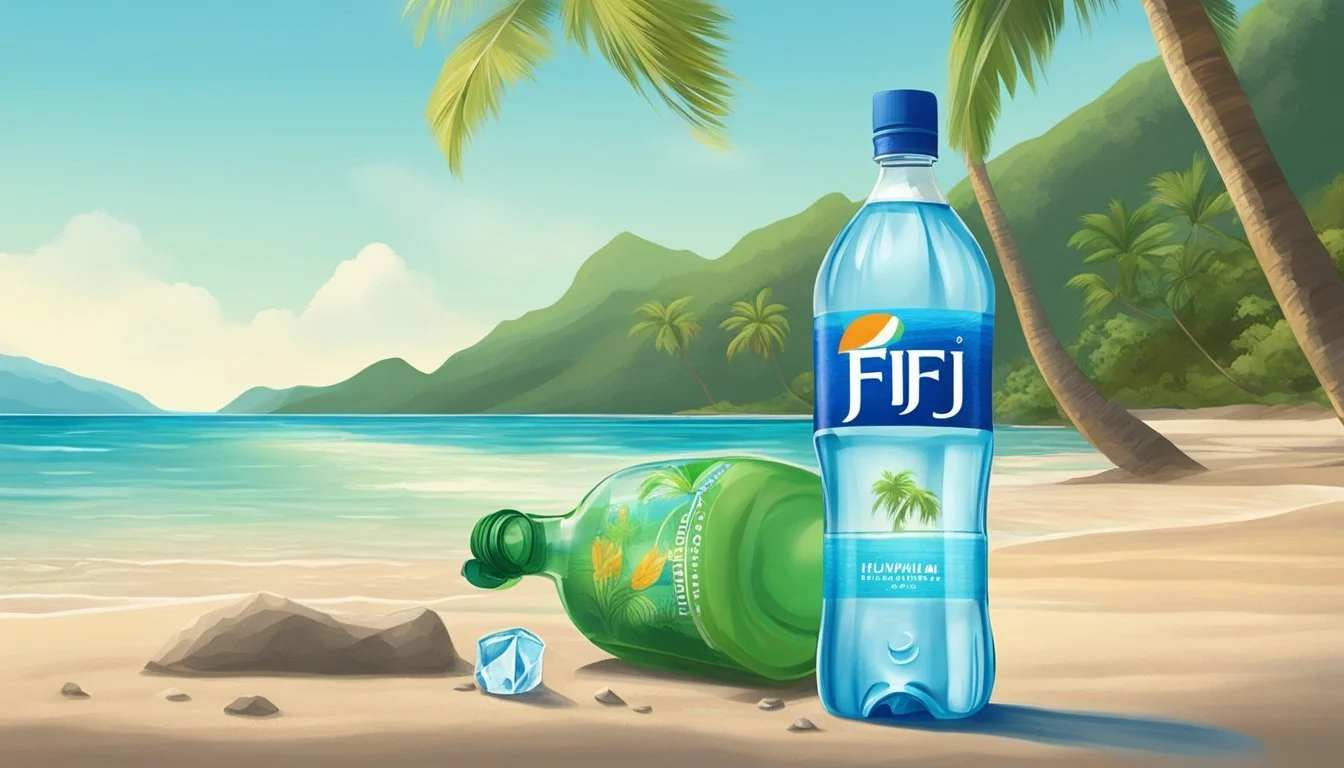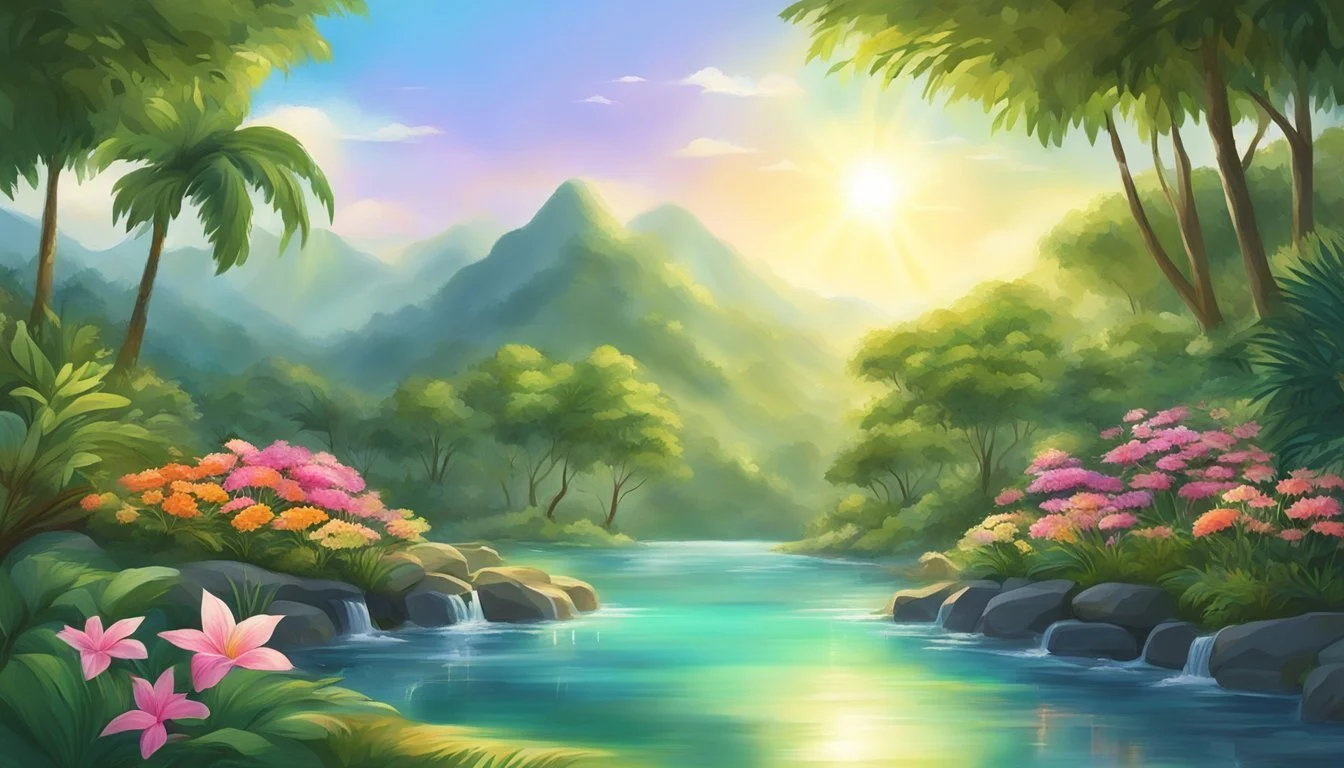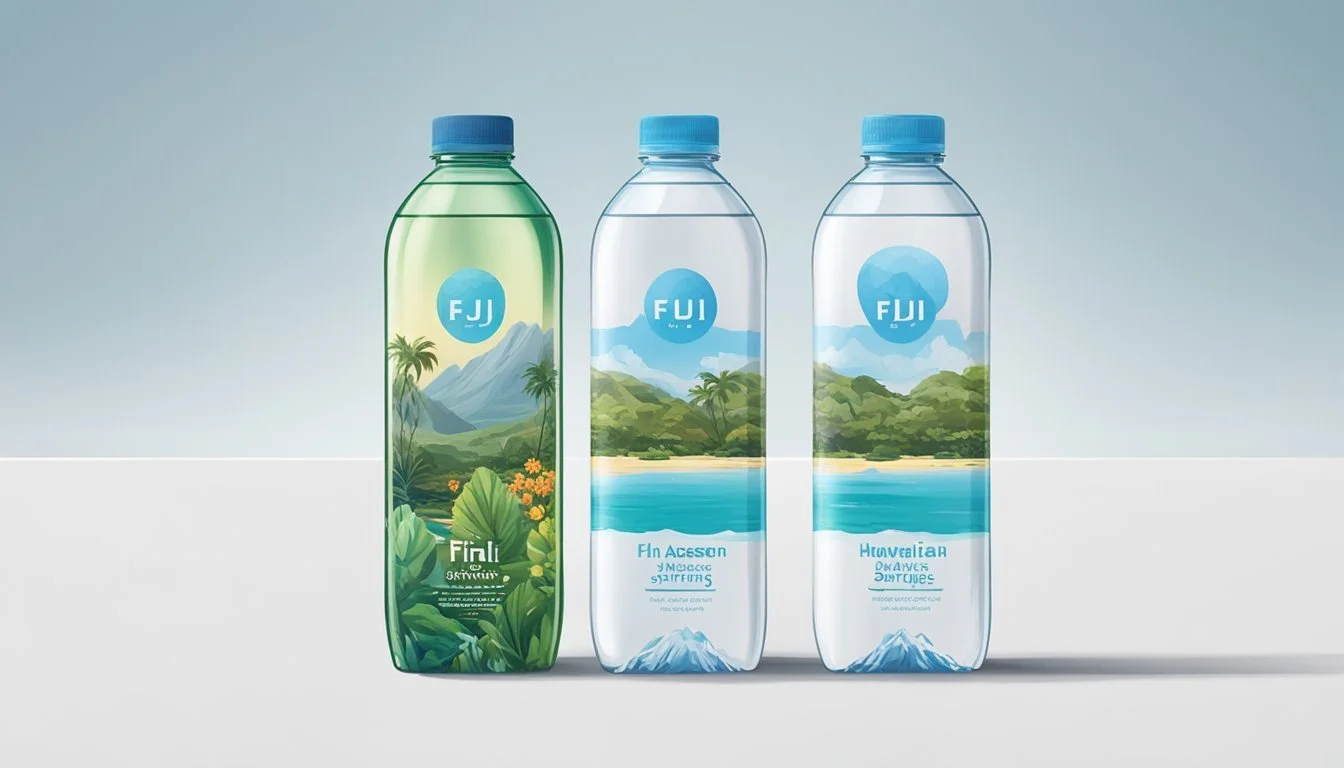Fiji vs. Hawaiian Springs
Which Bottled Water is Better? Comparative Analysis and Recommendations
Comparing bottled water brands often brings out surprising differences, even among high-quality options. When it comes to Fiji vs. Hawaiian Springs, consumers frequently debate which is better. Fiji Water is renowned for its smooth taste and is sourced from an aquifer in Fiji. Hawaiian Springs offers water that is naturally filtered through Mauna Loa's lava rock, providing a distinctly pure taste.
Both brands have loyal followings, and their distinct sources add unique qualities to each. Fiji's silica content is praised for contributing to its soft mouthfeel, while the volcanic filtration of Hawaiian Springs enhances its clean, crisp taste. Consumers looking for a refreshing and pure experience may find either option appealing based on these characteristics.
Ultimately, your choice between Fiji and Hawaiian Springs will likely come down to personal preference. While both brands offer excellent quality, some might prefer the soft, silky texture of Fiji, while others might enjoy the crisp, clean profile of Hawaiian Springs. Dive into the detailed comparison to discover which bottled water truly stands out for you.
Context and Relevance of Bottled Water
Bottled water has become a staple in modern hydration, driven by factors like convenience, perceived purity, and specialized benefits. The evolution of the industry and shifts in consumer preferences provide a clear picture of its place in today's market.
Evolution of the Bottled Water Industry
The bottled water industry has grown significantly since its inception. Early bottled water primarily came from natural springs, marketed for its purity. Brands like FIJI and Hawaiian Springs have capitalized on this, promoting their water's natural source and unique qualities.
Technological advancements have also played a role. Enhanced filtration methods like carbon filtration and UV treatment ensure safety and consistency. This evolution has expanded the market from basic bottled water to premium options with added minerals and distinct flavors.
Environmental concerns have emerged with this growth. The production and transportation of bottled water consume significant resources. For instance, manufacturing and transporting a single bottle of FIJI water uses approximately 7.1 gallons of water, 1 liter of fossil fuels, and results in 1.2 pounds of greenhouse gases. This has led to a push for sustainability in packaging and sourcing.
Consumer Preferences and Trends
Consumers today are discerning about their bottled water choices. They seek convenience, taste, and health benefits. Premium brands like FIJI and Hawaiian Springs are often chosen for their perceived superior quality and unique mineral content.
Taste tests have shown that preferences can vary widely, with some consumers favoring the crisp taste of mineral-rich waters. For example, a blind taste test ranked different bottled water brands from F-tier to S-tier based on flavor, demonstrating the subjective nature of taste.
Health and environmental impact are also key considerations. FIJI water, for example, is often considered healthier than flavored bottled waters. However, its use of single-use plastic raises environmental concerns, highlighting the need for more sustainable options.
Brands are now increasingly transparent about their sourcing and production processes. This transparency, coupled with growing environmental awareness, influences consumer choices, pushing the market towards eco-friendly packaging and ethical sourcing.
Source and Natural Composition
Fiji Water and Hawaiian Springs are both renowned for their unique sources and natural filtration methods. The origin and composition of these waters greatly influence their taste and mineral content.
Fiji Water: Artesian Aquifer and Volcanic Rock Filtration
Fiji Water originates from an artesian aquifer located deep within the islands of Fiji. This source is shielded from environmental pollutants by layers of volcanic rock, which naturally filter the water.
The volcanic rock filtration process enriches the water with silica, a mineral known for its smooth, soft texture. Fiji Water also contains other vital minerals like calcium and magnesium, adding to its refreshing taste and perceived health benefits.
Hawaiian Springs: Natural Spring Water and Island Origin
Hawaiian Springs sources its water from natural springs on the Big Island of Hawaii. These springs are fed by aquifers situated deep beneath the island's surface, carrying water that has been naturally filtered through lava rock.
This process imparts a distinct mineral composition, including potassium and magnesium. Hawaiian Springs emphasizes the purity and natural quality of its water, promoting a clean, crisp taste that reflects its pristine island origin.
Quality and Purity
Assessing the quality and purity of Fiji and Hawaiian Springs bottled water involves examining their taste, mouthfeel, mineral content, health benefits, safety standards, and quality assurance measures.
Taste and Mouthfeel
Fiji Water is renowned for its smooth and velvety texture, providing a subtle sweetness that many find refreshing. This is attributed to its natural artesian aquifer source in Viti Levu, Fiji.
Hawaiian Springs offers a crisp and clean taste, sourced from the Kea'au aquifer on Hawaii's Big Island. Its mouthfeel is often described as light, with a hint of natural sweetness that appeals to many consumers.
Mineral Content and Health Benefits
Fiji Water boasts a unique mineral profile, rich in silica, calcium, and magnesium. The silica content is especially noteworthy, potentially benefiting skin, hair, and nails.
Hawaiian Springs also has a beneficial mineral composition, including calcium and magnesium. It is known for a slightly higher alkalinity, which some believe can aid in balancing the body's pH.
Mineral Fiji Water (mg/L) Hawaiian Springs (mg/L) Silica 93 31.8 Calcium 18 6.0 Magnesium 15 3.0
Safety Standards and Quality Assurance
Fiji Water adheres to stringent safety protocols, including third-party testing, ensuring contaminants are well below permissible limits.
Hawaiian Springs implements rigorous quality assurance measures, regularly testing for purity and compliance with safety regulations. Both brands use advanced filtration processes, maintaining the integrity and safety of their water sources.
Environmental Considerations
Understanding the environmental impact of bottled water entails looking at packaging sustainability and the environmental footprint of water bottling processes.
Packaging and Sustainability
Packaging, especially plastic bottles, significantly influences the environmental impact of bottled water. Fiji Water predominantly uses PET plastic for its bottles, which, while recyclable, often end up in landfills.
Hawaiian Springs also relies on plastic but claims to use more environmentally friendly materials.
Recycling rates for plastic bottles remain low globally, contributing to environmental pollution. For an environmentally friendly approach, brands might consider alternative materials or incentivize bottle recycling.
Environmental Footprint of Water Bottling Processes
The water bottling process itself has a substantial environmental footprint. Fiji Water sources its water from remote artesian aquifers in Fiji, requiring significant energy for transportation to global markets.
This long-distance distribution adds to carbon emissions. Meanwhile, Hawaiian Springs sources from local Hawaiian aquifers, potentially reducing transportation-related emissions.
Energy use and water wastage during the bottling stages are also critical concerns. Both brands need to address these issues to mitigate their environmental impact. Investing in energy-efficient technologies and better water management practices can pave the way for more sustainable operations.
Comparison of Properties
Both Fiji and Hawaiian Springs bottled waters have distinct properties that influence their pH levels, mineral content, and taste profile. By examining these attributes, one can make an informed choice about which water is better suited to their preferences and needs.
pH Levels and Alkalinity
Fiji Water is known for having a pH level of around 7.7, which places it in the alkaline range. This alkalinity is derived from its natural filtration through volcanic rock, which introduces silica and minerals.
Hawaiian Springs, on the other hand, typically has a pH of approximately 7.8 to 8.2, making it slightly more alkaline than Fiji. This natural alkalinity also results from its source, natural aquifers in Hawaii. Both waters' alkalinity can help neutralize acid in the body.
Electrolytes and Mineral Balance
Fiji Water contains a balanced mix of electrolytes and minerals, including significant levels of silica, calcium, and magnesium. The silica content gives the water a smooth mouthfeel, while calcium and magnesium are essential for various bodily functions.
Hawaiian Springs water boasts a similar mineral profile but tends to have higher levels of calcium and magnesium compared to Fiji. While both waters provide essential electrolytes that support hydration and overall health, Hawaiian Springs' elevated mineral content can be advantageous for those seeking additional dietary minerals.
Comparison of Taste Profile
Fiji Water is often described as having a smooth and soft taste, largely owing to its silica content. It is free from any metallic or chemical aftertaste, making it a popular choice for those who prefer a neutral, clean flavor.
Hawaiian Springs features a crisp, refreshing taste, likely influenced by its higher alkalinity and unique mineral composition. The water is described as light and pure with a slight hint of natural sweetness, providing a distinctly different experience from Fiji.
Both Fiji and Hawaiian Springs cater to varying taste preferences, with Fiji offering a softer profile and Hawaiian Springs delivering a crisper sensation.
Consumer Experience
Consumers often gauge bottled water by brand perception, pricing, value, and convenience. Understanding these factors can shed light on why some prefer Fiji over Hawaiian Springs, or vice versa.
Brand Perception and Marketing
Fiji Water has built a strong brand identity around luxury and purity. Its distinctive square bottle and tropical imagery emphasize exclusivity and pristine origins. The brand's marketing often highlights its source in the remote Yaqara Valley, promoting the untouched nature of the water.
Hawaiian Springs markets itself with a focus on the purity and natural qualities of its water, sourced from Hawaiian aquifers. The branding emphasizes a connection to Hawaii's clean environment and culture. While not as aggressively marketed as Fiji, it appeals to those seeking authentic, nature-oriented products.
Pricing and Value for Money
The price of Fiji Water typically ranges from approximately $2.00 to $2.50 for a 500ml bottle. This positions it in the premium segment, appealing to consumers willing to pay more for perceived quality and luxury.
Hawaiian Springs generally offers a more affordable option, with prices usually around $1.50 to $2.00 for similar quantities. This makes it attractive to those looking for high-quality water without the luxury price tag. The value for money is a significant factor, especially for budget-conscious buyers.
Availability and Convenience
Fiji Water is widely available in various retail locations, from grocery stores to high-end hotels and restaurants. Its broad distribution network makes it easy to find, contributing to its popularity.
Hawaiian Springs may not be as ubiquitous, but it is often stocked in specialty stores and online. The slightly limited availability can impact convenience for some consumers, though it retains a dedicated customer base that values its unique source and taste.
Final Assessment
When evaluating Fiji Water and Hawaiian Springs, several factors need to be considered to determine which is the better bottled water.
Taste
Fiji Water is often praised for its smooth and silky taste. It is preferred by many consumers for its refreshing quality. Hawaiian Springs also boasts a pure and clean taste, often likened to a fresh mountain stream.
Source and Purity
Fiji Water comes from an aquifer in Viti Levu, Fiji, suggesting a pristine source. Similarly, Hawaiian Springs is sourced from an artesian well in Hawaii, highlighting its purity. Both brands emphasize their natural and untouched sources.
pH Levels
Fiji Water has a pH level of approximately 7.7, making it naturally alkaline. Hawaiian Springs' pH level ranges around 7.7 as well, reflecting similar alkalinity.
Environmental Impact
Fiji Water has faced criticism for its use of single-use plastic bottles, which contribute to environmental pollution. Hawaiian Springs also uses plastic packaging, raising similar concerns.
Price
Fiji Water tends to be more expensive than Hawaiian Springs. This could affect consumer choice, especially for those looking for a more economical option.
Feature Fiji Water Hawaiian Springs Taste Smooth, Silky Pure, Clean Source Viti Levu, Fiji Artesian Well, Hawaii pH Level 7.7 7.7 Environmental Impact Single-use Plastic Single-use Plastic Price Higher Lower
Expert Opinions
Water sommeliers often rate Fiji Water highly for its taste and mineral content. Hawaiian Springs is also well-regarded but less often discussed among experts.
Consumer Preference
Ultimately, consumer preference varies, with some favoring the exotic allure of Fiji Water, while others appreciate the clean simplicity and often lower price of Hawaiian Springs.
More About Fiji
Fiji vs Mountain Valley Spring Water: Which Bottled Water is Better?
Fiji vs Whole Foods Italian Still Mineral water: Which Bottled Water is Better?
More About Hawaiian Springs
Acqua Pana vs Hawaiian Springs: Which Bottled Water is Better?
Aqua Carpatica vs Hawaiian Springs: Which Bottled Water is Better?
Aquafina vs Hawaiian Springs: Which Bottled Water is Better?
Arrowhead vs Hawaiian Springs: Which Bottled Water is Better?
Boxed Water vs Hawaiian Springs: Which Bottled Water is Better?
Castle Rock vs Hawaiian Springs: Which Bottled Water is Better?
Core Hydration vs Hawaiian Springs: Which Bottled Water is Better?
Deer Park vs Hawaiian Springs: Which Bottled Water is Better?
Essentia vs Hawaiian Springs: Which Bottled Water is Better?
Hawaiian Springs vs 1907water: Which Bottled Water is Better?
Hawaiian Springs vs 7-Select: Which Bottled Water is Better?
Hawaiian Springs vs Alkaline88: Which Bottled Water is Better?
Hawaiian Springs vs Antipodes: Which Bottled Water is Better?
Hawaiian Springs vs Big Chill: Which Bottled Water is Better?
Hawaiian Springs vs BodyArmor: Which Bottled Water is Better?
Hawaiian Springs vs Cascade Mountain: Which Bottled Water is Better?
Hawaiian Springs vs CBD Living: Which Bottled Water is Better?
Hawaiian Springs vs Crystal Geyser: Which Bottled Water is Better?
Hawaiian Springs vs Crystal Lake: Which Bottled Water is Better?
Hawaiian Springs vs Essence pH10: Which Bottled Water is Better?
Hawaiian Springs vs Hawaii Volcanic: Which Bottled Water is Better?
Hawaiian Springs vs Kirkland Signature: Which Bottled Water is Better?
Hawaiian Springs vs Liquid Death: Which Bottled Water is Better?
Hawaiian Springs vs Mananalu: Which Bottled Water is Better?
Hawaiian Springs vs Open Water: Which Bottled Water is Better?
Hawaiian Springs vs Proud Source: Which Bottled Water is Better?
Hawaiian Springs vs Pure Life: Which Bottled Water is Better?
Hawaiian Springs vs Purely Sedona: Which Bottled Water is Better?
Hawaiian Springs vs Refreshe: Which Bottled Water is Better?
Hawaiian Springs vs Richard's Rainwater: Which Bottled Water is Better?
Hawaiian Springs vs Simple Truth: Which Bottled Water is Better?
Hawaiian Springs vs Solan de Cabras: Which Bottled Water is Better?
Hawaiian Springs vs Talking Rain AQA: Which Bottled Water is Better?
Hawaiian Springs vs The Well: Which Bottled Water is Better?
Hawaiian Springs vs Tru Alka: Which Bottled Water is Better?
Hawaiian Springs vs Weird Water: Which Bottled Water is Better?
Hawaiian Springs vs Whole Foods 365: Which Bottled Water is Better?
Hawaiian Springs vs Whole Foods Italian Still Mineral water: Which Bottled Water is Better?
Ice Mountain vs Hawaiian Springs: Which Bottled Water is Better?
Icelandic Glacial vs Hawaiian Springs: Which Bottled Water is Better?
Just Water vs Hawaiian Springs: Which Bottled Water is Better?
Mountain Valley Spring Water vs Hawaiian Springs: Which Bottled Water is Better?
Nestle Pure Life vs Hawaiian Springs: Which Bottled Water is Better?
Poland Spring vs Hawaiian Springs: Which Bottled Water is Better?
San Pellegrino vs Hawaiian Springs: Which Bottled Water is Better?
Smartwater vs Hawaiian Springs: Which Bottled Water is Better?
Topo Chico vs Hawaiian Springs: Which Bottled Water is Better?
Zephyrhills vs Hawaiian Springs: Which Bottled Water is Better?






